Last month was designated American Heart Month to raise awareness of cardiovascular disease, the leading fatality of Americans. AHA encourages our patients to take control over understanding their risk factors of heart disease including knowing their numbers related to blood pressure. Untreated hypertension can have a long-term effect on the heart causing hypertensive heart disease, which can include coronary heart disease (CAD), left ventricular hypertrophy (LVH) and hypertrophic cardiomyopathy (HCM).
Echocardiography plays a major role in the prognostic evaluation of hypertension (HTN). The main contribution of echo in the management of hypertension is the assessment of left ventricular mass (LVM). In this blog we describe left ventricular hypertrophy (LVH) and identify the different categories of concentric, eccentric and concentric remodeling. In Part 2 of the blog we will elaborate on LV Mass (LVM) and Relative Wall Thickness (RWT). We will provide step-by-step instructions on how to obtain these values during a routine echocardiogram.
WHAT IS LVH?
Left ventricular hypertrophy is a form of cardiac remodeling that causes the heart wall muscle to thicken, which leads to an increase in LV mass (LVM). There are different sub-categories that fall into the diagnosis of LVH, which includes concentric, eccentric and concentric remodeling.
There are key factors that play a major role in determining the presence of LVH:

We cannot cover all of these within this blog series but it’s important to know that the heart size is influenced by body size. Remember:
- Men have larger hearts than women
- Athletes have larger hearts than non-athletes
- Obese patients have larger hearts than non-obese patients
Let’s briefly talk about what occurs as the heart enlarges.
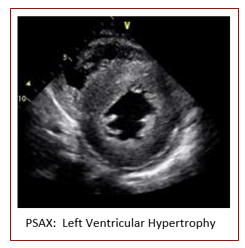 | Enlarged hearts: ↑ wall (fibre) stress = ↑ wall thickness = ↑ LV size (radius & volume)In patients with chronic high systolic blood pressure the heart wall will become thickened due to the wall stress from hypertension |
CONCENTRIC LVH
Concentric LVH is the result of the heart adapting to high systemic pressure overload caused by hypertension or other diseases such as aortic stenosis. Peripheral resistance is increased. Concentric LVH affects both men and women, regardless of age. It is associated with changes in LV geometry, diastolic function, longitudinal and radial myocardial function and atrial size.
The hallmark echocardiographic signs of concentric LVH include:
- Global increased wall thickness
- Normal LV cavity size
- Increased LVM (Left ventricular mass)
- Increased RWT (Relative Wall thickness)
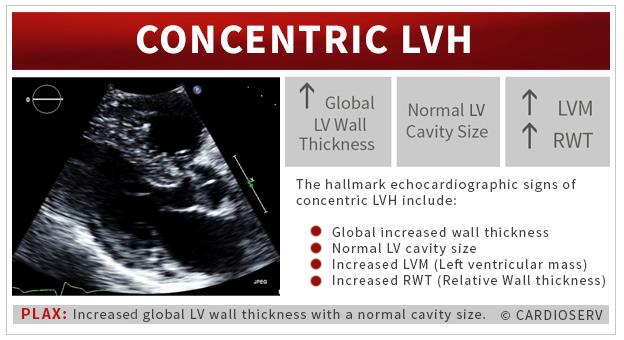
ECCENTRIC LVH
On the other hand, eccentric hypertrophy deals with volume overload due to a significant valvular regurgitation issue or high cardiac index. The systemic pressures will be normal and the peripheral resistance is not increased. This category of patients will have changes in both diastolic function and the longitudinal and radial function. They will show to have either a low normal or a mildly impaired systolic function due to having chronic volume overload. The shape of the LV will change, becoming more spherical since the LV will be enlarged..
The hallmark echocardiographic signs of eccentric LVH include:
- Normal LV wall thickness
- Increased LV cavity size
- Increased LVM (Left ventricular mass)
- Decreased RWT (Relative Wall thickness)
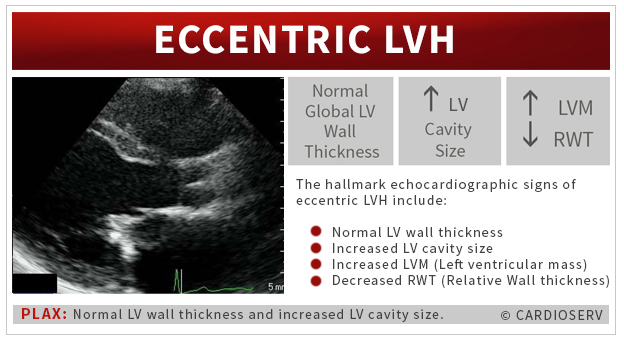
CONCENTRIC REMODELING
Concentric remodeling is the late stage response to LV hypertrophy; caused by either chronic pressure, volume overload or a MI (which is commonly associated with CAD, but can be due to longstanding hypertension, especially untreated). Concentric remodeling will demonstrate systolic dysfunction along with changes in the LV geometry. The shape of the LV changes and becomes more rounded, rather than bullet shaped. You will notice the rapid degradation of diastolic dysfunction and loss of radial and longitudinal function.
The hallmark echocardiographic signs of concentric remodeling include:
- Usually increased LV wall thickness
- Normal or small LV cavity size
- Normal LVM (Left ventricular mass)
- Increased RWT (Relative Wall thickness)
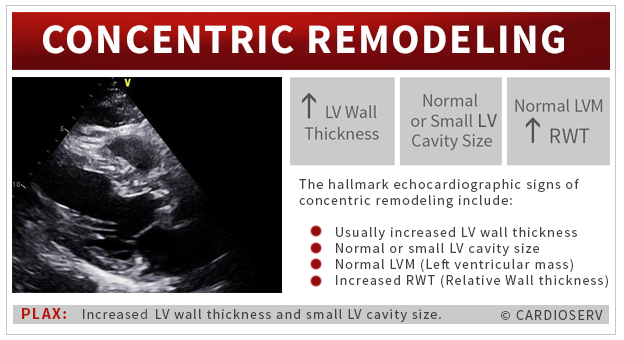
REMEMBER
- Concentric LVH = Pressure Overload (BP)
- Eccentric LVH = Volume Overload (Regurgitation)
- Remodeling = CHRONIC pressure & volume overload or MI
CONCLUSION
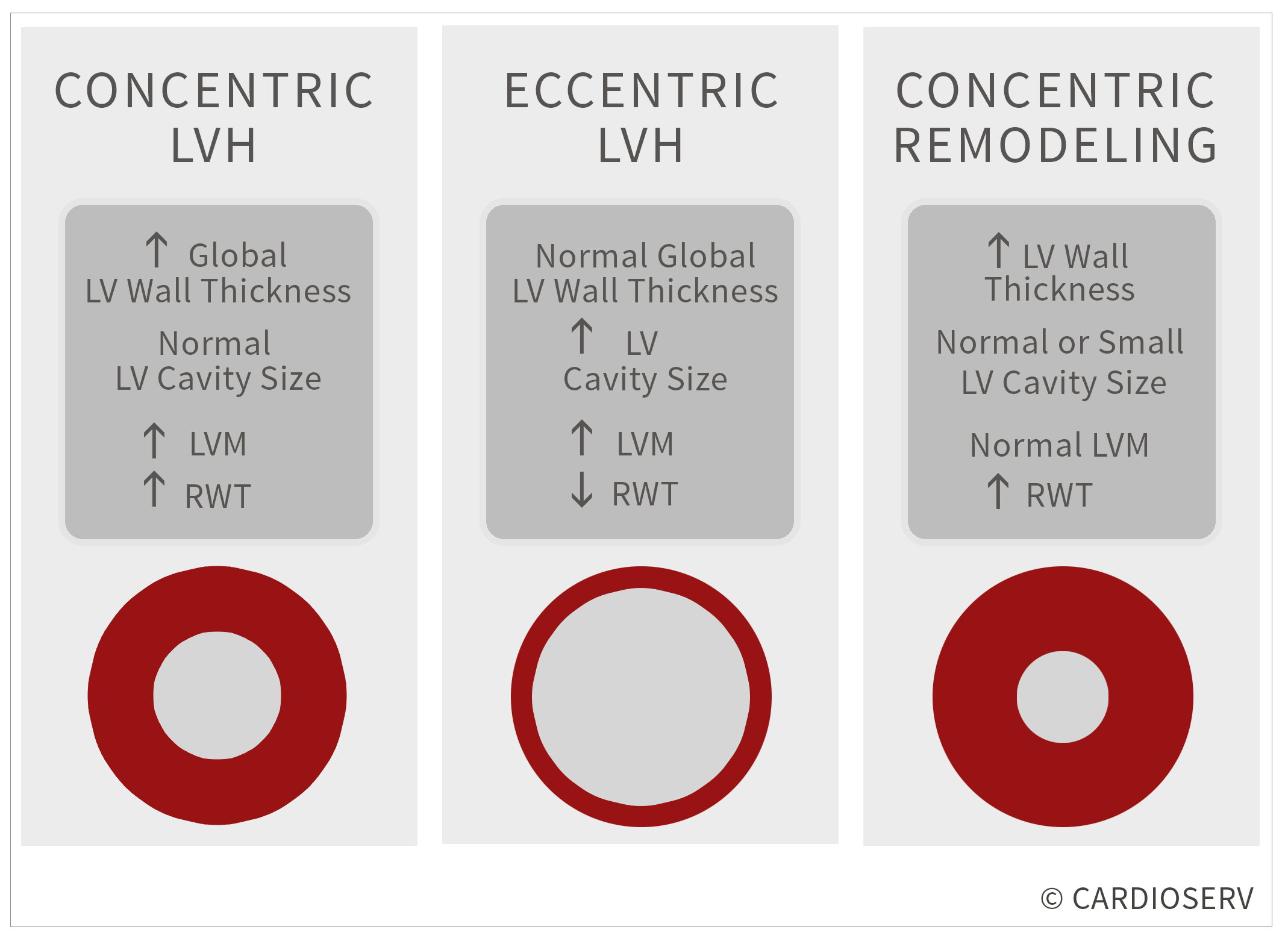
Our goal this week was to provide you with a better understanding of the pathophysiology behind the various categories of LVH. This table will provide you with a better understanding of the echocardiographic findings found in the subcategories of left ventricular hypertrophy (LVH). We discussed how LV mass (LVM) and relative wall thickness (RWT) plays a role in identifying the categories of LVH. But what is LVM and RWT?? How do we obtain them? In the second part of our LVH blog series, we will provide step-by step instructions on how to obtain these values.
REFERENCES
- Alam, S. (n.d.). The Edinburgh Cardiology Imaging Website. Retrieved March 01, 2017, from http://webservice1.mvm.ed.ac.uk/imaging/demo/cases/cardiac-amyloid-echo.html
- Marwick, T. H., PhD, Gillebert, T. C., MD, & G. A., MD. (2015). Recommendations on the Use of Echocardiography in Adult Hypertension. JASE,28(7), 1-12. Retrieved March 1, 2017, from http://asecho.org/wordpress/wp-content/uploads/2015/07/2015_Hypertension.pdf
- Lang, R. M., MD, Badano, L. P., MD, & Mor-Avi, V., PhD. (2015). Recommendations for Cardiac Chamber Quantification by Echocardiography in Adults: An Update from the American Society of Echocardiography and the European Association of Cardiovascular Imaging. JASE, 28(1), 1-53. Retrieved March 1, 2017, from http://asecho.org/wordpress/wp-content/uploads/2015/01/ChamberQuantification2015.pdf






